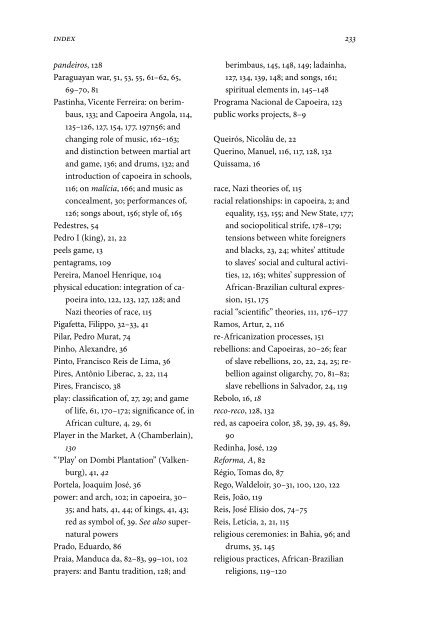Index pandeiros, 128 paraguayan war, 51, 53, 55, 61–62, 65, 69–70, 81 past<strong>in</strong>ha, Vicente ferreira: on berimbaus, 133; and <strong>Capoeira</strong> angola, 114, 125–126, 127, 154, 177, 197n56; and chang<strong>in</strong>g role <strong>of</strong> music, 162–163; and dist<strong>in</strong>ction between martial art and game, 136; and drums, 132; and <strong>in</strong>troduction <strong>of</strong> capoeira <strong>in</strong> schools, 116; on malícia, 166; and music as concealment, 30; performances <strong>of</strong>, 126; songs about, 156; style <strong>of</strong>, 165 pedestres, 54 pedro i (k<strong>in</strong>g), 21, 22 peels game, 13 pentagrams, 109 pereira, Manoel Henrique, 104 physical education: <strong>in</strong>tegration <strong>of</strong> capoeira <strong>in</strong>to, 122, 123, 127, 128; and nazi <strong>the</strong>ories <strong>of</strong> race, 115 pigafetta, filippo, 32–33, 41 pilar, pedro Murat, 74 p<strong>in</strong>ho, alexandre, 36 p<strong>in</strong>to, francisco reis de Lima, 36 pires, antônio Liberac, 2, 22, 114 pires, francisco, 38 play: classification <strong>of</strong>, 27, 29; and game <strong>of</strong> life, 61, 170–172; significance <strong>of</strong>, <strong>in</strong> african culture, 4, 29, 61 player <strong>in</strong> <strong>the</strong> Market, a (Chamberla<strong>in</strong>), 0 “‘play’ on dombi plantation” (Valkenburg), 41, portela, Joaquim José, 36 power: and arch, 102; <strong>in</strong> capoeira, 30– 35; and hats, 41, 44; <strong>of</strong> k<strong>in</strong>gs, 41, 43; red as symbol <strong>of</strong>, 39. See also supernatural powers prado, eduardo, 86 praia, Manduca da, 82–83, 99–101, 102 prayers: and Bantu tradition, 128; and berimbaus, 145, 148, 149; lada<strong>in</strong>ha, 127, 134, 139, 148; and songs, 161; spiritual elements <strong>in</strong>, 145–148 programa nacional de <strong>Capoeira</strong>, 123 public works projects, 8–9 Queirós, nicolãu de, 22 Quer<strong>in</strong>o, Manuel, 116, 117, 128, 132 Quissama, 16 race, nazi <strong>the</strong>ories <strong>of</strong>, 115 racial relationships: <strong>in</strong> capoeira, 2; and equality, 153, 155; and new state, 177; and sociopolitical strife, 178–179; tensions between white foreigners and blacks, 23, 24; whites’ attitude to slaves’ social and cultural activities, 12, 163; whites’ suppression <strong>of</strong> african-<strong>Brazilian</strong> cultural expression, 151, 175 racial “scientific” <strong>the</strong>ories, 111, 176–177 ramos, artur, 2, 116 re-africanization processes, 151 rebellions: and <strong>Capoeira</strong>s, 20–26; fear <strong>of</strong> slave rebellions, 20, 22, 24, 25; rebellion aga<strong>in</strong>st oligarchy, 70, 81–82; slave rebellions <strong>in</strong> salvador, 24, 119 rebolo, 16, reco-reco, 128, 132 red, as capoeira color, 38, 39, , 45, 89, 90 red<strong>in</strong>ha, José, 129 Reforma, A, 82 régio, tomas do, 87 rego, Waldeloir, 30–31, 100, 120, 122 reis, João, 119 reis, José elísio dos, 74–75 reis, Letícia, 2, 21, 115 religious ceremonies: <strong>in</strong> Bahia, 96; and drums, 35, 145 religious practices, african-<strong>Brazilian</strong> religions, 119–120
eligious processions, and <strong>Capoeira</strong>s, 61, 63, 64, 65–68, 176 República, A, 82, 83–84 republican regime, 111–112, 152 republicans, 81, 84–86 resolution 122 (1824), 11 resolution 182 (1824), 9 Revista Kosmos, 79, 81, 87, 90, 112 ribeiro de resende, estavão, 11 ribeyrolles, Charles, 12, 31 rio, João do, 105 rio de Janeiro: capoeira <strong>in</strong>, 4, 5, 7, 114, 115, 117–118, 177; drumm<strong>in</strong>g forbidden <strong>in</strong>, 35; mercenaries’ revolt <strong>of</strong> 1828, 21–24; neighborhoods <strong>of</strong>, 60, 60, 61, 63, 76–77, ; orig<strong>in</strong> <strong>of</strong> african nations <strong>of</strong>, 16, ; population <strong>of</strong>, 50, , 57, 73–74; slave population <strong>of</strong>, 14, , 118; slave trade with Bahia, 24–25, 196n33; unemployment <strong>in</strong>, 111; yoruban culture <strong>in</strong>, 3 rituals: and african culture, 175; <strong>Capoeira</strong>s’ use <strong>of</strong>, 36; and cartwheels, 148; <strong>of</strong> challenge, 138, 199n94; and chamada, 160, 168, 6 ; and color, 146; exclusion <strong>of</strong>, 148; and manufacture <strong>of</strong> talk<strong>in</strong>g drums, 135; and medic<strong>in</strong>es, 95; and pass<strong>in</strong>g under arch, 102; and prayers, 146; and roda, 141–145; and spiritual elements <strong>of</strong> capoeira, 5, 176; syn<strong>the</strong>sis <strong>of</strong>, 176; <strong>of</strong> West africa, 173; <strong>of</strong> West Central africa, 95, 173 robertson, John, 7 roda (circle): and arch, 102; <strong>in</strong> Bahia, 119; and concealment <strong>of</strong> capoeira, 154; formation <strong>of</strong>, 141–142, 148; and musicians as players and spectators, 159–163; as physical concept, 142– 144; symbolic significance <strong>of</strong>, 144– 145; three capoeira circles, , 145; and time and space, 163–164 Index roda aberta (open circle), 164 rodrigues, Lafayette, 84 rodrigues, n<strong>in</strong>a, 116 rombo, Jacomo, 25 romero, silvio, 76 rugendas, João Maurício: on capoeira as war dance, 8, 27; <strong>Capoeira</strong> Game, , 31, 45, 95–96, 98, 117; Ceremony for our Lady <strong>of</strong> <strong>the</strong> rosary, 6 ; and cloth<strong>in</strong>g <strong>of</strong> <strong>Capoeira</strong>s, 53; on conditions <strong>of</strong> slaves, 28; São Salvador, 0, 117 runaway slaves: and orig<strong>in</strong> <strong>of</strong> capoeira, 18, 154, 157, 184n34; and palmares, 156–157 saamakan Vessel-on-Column altar, sur<strong>in</strong>am (1885), 41, sales, Campos, 86 salvador: rio de Janeiro compared to, 117–118; and slave rebellions, 24, 119; and tourism, 127 salvadori, Maria angela Borges, 2, 104–105, 169 samba: and folklore, 153; and national identity, 2, 115, 152, 177; popularity <strong>of</strong>, 120; songs <strong>of</strong>, 169–170; and tourism, 156; whites’ adopt<strong>in</strong>g <strong>of</strong>, 163 santo antônio procession, 66 santo dom<strong>in</strong>go revolt, 116 santos, João oliveira dos, 127 santos, João pereira dos, 126–127 santos, Mario, 112–113 são Jorge parade, 66 são paulo, 118, 152 São Salvador (rugendas), 0, 117 scenes <strong>of</strong> Magic (Cavazzi), 92, schlichthorst, Carl, 47, 48, 129–130 scott, James, 61 seabra, décio, 123 seal <strong>of</strong> solomon, 107–109, 0 showcase <strong>Capoeira</strong>, 164
- Page 2 and 3:
The Hidden History of Capoeira
- Page 4 and 5:
The Hidden History of Capoeira A Co
- Page 6 and 7:
To my parents, Ruth and Dan, my hus
- Page 8 and 9:
foreword ix acknowledgments xi intr
- Page 10 and 11:
Foreword OVeR The pAST decade i hav
- Page 12:
ACknowled gments ThIS BOOk, wRITTeN
- Page 15 and 16:
THIS PAGE INTENTIONALLY LEFT BLANK
- Page 17 and 18:
IntroductIon vantages of capoeira a
- Page 19 and 20:
IntroductIon on the form. The incre
- Page 21 and 22:
THIS PAGE INTENTIONALLY LEFT BLANK
- Page 23 and 24:
chapter bique and Quilumana, Cabind
- Page 25 and 26:
0 chapter FIGuRe 1.2. São Salvador
- Page 27 and 28:
chapter forbidden activities such a
- Page 29 and 30:
chapter use of weapons and sticks;
- Page 31 and 32:
6 chapter MAp 1.1. The transatlanti
- Page 33 and 34:
Table 1.3. Origin of Arrested Capoe
- Page 35 and 36:
0 chapter who hurled stones at the
- Page 37 and 38:
chapter situation, whereupon the la
- Page 39 and 40:
chapter Walsh expressed deep frustr
- Page 41 and 42:
6 chapter publicized. Luis da Costa
- Page 43 and 44:
Blacks’ Games and Dances chapter
- Page 45 and 46:
0 chapter achieve physical and ment
- Page 47 and 48:
chapter FIGuRe 1.3. ngoma drum, n.d
- Page 49 and 50:
FIGuRe 1.5. ngoma drummer in Headav
- Page 51 and 52:
6 chapter Capoeira and the Appeal t
- Page 53 and 54:
chapter The colors of the hats and
- Page 55 and 56:
0 chapter FIGuRe 1.8. Warriors prep
- Page 57 and 58:
FIGuRe 1.10. “‘play’ on dombi
- Page 59 and 60:
chapter FIGuRe 1.13. Court of a Con
- Page 61 and 62:
FIGuRe 1.15. Slaves Fighting (ca. 1
- Page 63 and 64:
chapter around naked in the city st
- Page 65 and 66:
0 chapter Table 2.1. Origin of Arre
- Page 67 and 68:
chapter mino was not a freedman, he
- Page 69 and 70:
chapter status symbol. slaves tende
- Page 71 and 72:
6 chapter concluded that even harsh
- Page 73 and 74:
chapter The most common street crim
- Page 75 and 76:
60 chapter MAp 2.1. The neighborhoo
- Page 77 and 78:
6 chapter ernment for their heroic
- Page 79 and 80:
6 chapter their anonymity in the cr
- Page 81 and 82:
66 chapter lice and soldiers. The f
- Page 83 and 84:
6 chapter strating their scorn and
- Page 85 and 86:
0 chapter were looking for solution
- Page 87 and 88:
chapter • José ribeiro was arres
- Page 89 and 90:
chapter constituting 56 percent of
- Page 91 and 92:
6 chapter rista performing in front
- Page 93 and 94:
chapter MAp 3.2. nagoa and Guaiamu
- Page 95 and 96:
0 chapter prata [silver Birthmark]
- Page 97 and 98:
chapter the old oligarchy, especial
- Page 99 and 100:
chapter been fully and sadly confir
- Page 101 and 102:
6 chapter ponents of the republic.
- Page 103 and 104:
FIGuRe 3.4. a fight between two Cap
- Page 105 and 106:
0 chapter members of mixed blood, m
- Page 107 and 108:
chapter FIGuRe 3.8. Scenes of Magic
- Page 109 and 110:
chapter FIGuRe 3.9. Vendor of Arrud
- Page 111 and 112:
6 chapter FIGuRe 3.11. Man and Woma
- Page 113 and 114:
chapter FIGuRe 3.14. atabaque drum
- Page 115 and 116:
00 chapter FIGuRe 3.16. altar in Ba
- Page 117 and 118:
0 chapter rituals were described by
- Page 119 and 120:
0 chapter God,” evidence of the a
- Page 121 and 122:
06 chapter amulets were widely used
- Page 123 and 124:
0 chapter FIGuRe 3.18. solomon’s
- Page 125 and 126:
0 chapter it is a sign that solomon
- Page 127 and 128:
chapter ethic as a major value, a r
- Page 129 and 130:
chapter nevertheless, he also enume
- Page 131 and 132:
6 chapter leader, to welcome famous
- Page 133 and 134:
chapter was the political center wh
- Page 135 and 136:
0 chapter that also served as socia
- Page 137 and 138:
chapter This description is especia
- Page 139 and 140:
chapter in 1972 the federação Bra
- Page 141 and 142:
6 chapter the name of his school. p
- Page 143 and 144:
chapter contestants, crossing onese
- Page 145 and 146:
0 chapter FIGuRe 4.3. a player in t
- Page 147 and 148:
chapter pronounced like l, and the
- Page 149 and 150:
angolinha, angola angolinha eu vou
- Page 151 and 152:
6 chapter But different Capoeiras s
- Page 153 and 154:
chapter of the dead. This is eviden
- Page 155 and 156:
0 chapter and depends on the mood o
- Page 157 and 158:
chapter tors converge to the specia
- Page 159 and 160:
chapter around the world. Hence the
- Page 161 and 162:
6 chapter each in his way. some cro
- Page 163 and 164:
chapter movements but assured me th
- Page 165 and 166:
THIS PAGE INTENTIONALLY LEFT BLANK
- Page 167 and 168:
chapter ception of aesthetics, time
- Page 169 and 170:
A. disciplined training, B. respect
- Page 171 and 172:
6 chapter sion and a slow process o
- Page 173 and 174:
Part 2. CaPoeira today: angola and
- Page 175 and 176:
60 chapter and style.21 The respons
- Page 177 and 178:
6 chapter The day i shone in itabai
- Page 179 and 180:
6 chapter today members of capoeira
- Page 181 and 182:
66 chapter embodied in the aspirati
- Page 183 and 184:
6 chapter FIGuRe 5.3. The Chamada (
- Page 185 and 186:
0 chapter sei que eles falam desse
- Page 187 and 188:
chapter This, according to acordeon
- Page 189 and 190:
THIS PAGE INTENTIONALLY LEFT BLANK
- Page 191 and 192:
6 epIloGue to train and prepare for
- Page 193 and 194:
epIloGue and poor, thereby perpetua
- Page 195 and 196:
THIS PAGE INTENTIONALLY LEFT BLANK
- Page 197 and 198: (rio de Janeiro: prefeitura da Cida
- Page 199 and 200: noteS to paGeS - 0 24 in Karasch, S
- Page 201 and 202: 6 noteS to paGeS - 75 a. tierou, Do
- Page 203 and 204: 126 schlichthorst, O Rio de Janeiro
- Page 205 and 206: 0 noteS to paGeS 6 -66 48 Manuel Qu
- Page 207 and 208: noteS to paGeS - 20 Vida Policial,
- Page 209 and 210: noteS to paGeS - 0 tonian Movement,
- Page 211 and 212: 6 noteS to paGeS - 11 ibid., p. 69.
- Page 213 and 214: noteS to paGeS - 63 Thompson, “Ca
- Page 215 and 216: 00 noteS to paGeS - 6 can dancers a
- Page 217 and 218: THIS PAGE INTENTIONALLY LEFT BLANK
- Page 219 and 220: 0 GloSSary Ginga: Basic step of cap
- Page 221 and 222: THIS PAGE INTENTIONALLY LEFT BLANK
- Page 223 and 224: 0 BIBlIoGraphy Correio Mercantil (r
- Page 225 and 226: 0 BIBlIoGraphy ajayi, folabo. “Ki
- Page 227 and 228: BIBlIoGraphy ———. Religiões
- Page 229 and 230: BIBlIoGraphy edmundo, Luíz. O Rio
- Page 231 and 232: 6 BIBlIoGraphy Krich, John. Why Is
- Page 233 and 234: BIBlIoGraphy pastinha, Vicente ferr
- Page 235 and 236: 0 BIBlIoGraphy summ, Harvey. Brazil
- Page 237 and 238: THIS PAGE INTENTIONALLY LEFT BLANK
- Page 239 and 240: poeiras’ mocking of, 57, 61, 64,
- Page 241 and 242: 6 Index of, 151, 164-166, 172; teac
- Page 243 and 244: disappearance, 104; and prayers, 14
- Page 245 and 246: 0 Index martial art distinguished f
- Page 247: 62, 75-76; An Electorate Bully, ; e
- Page 251 and 252: 6 Index songs: and berimbaus, 140;






